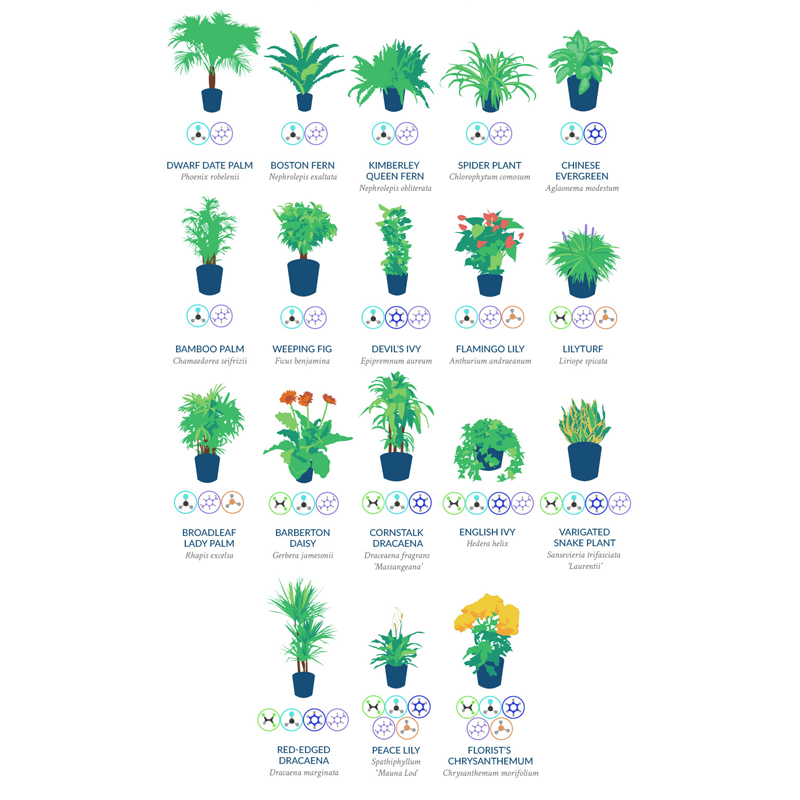ALA just released its 2016 State of Air report and it’s not pretty. If you live in Los Angeles, you will definitely want to continue reading, in fact if you reside in California many cities have been ranked highest on the ALA’s air pollution worst offending list.
Since there is little we can do to change the outside air we breath and the fact that we spend the bulk of our time indoors, be it at home or school or the office. It is therefore vital to ensure that our families have a high quality of air indoors.
NASA researchers set out to find the best ways to clean the air in space stations. Their Clean Air study found the plants below are effective at removing benzene, formaldehyde, and trichloroethylene, xylene, and ammonia from the air—chemicals that have been linked to health effects like headaches and eye irritation.
What’s actually in our air and what are the effects it has on humans?
Trichloroethylene
This can be found in printing inks, lacquers, varnishes, paint remover and adhesives. Depending on the amount of exposure to this toxic agent you could experience dizziness, headaches, nausea and vomiting.
Formaldehyde
Formaldehyde is usually found in paper bags, paper towels, synthetic fabrics, waxed papers and tissues. These all sound like pretty normal everyday things however short term exposure causes irritation to the nose, mouth and throat and in severe cases, swelling of the larynx and lungs.
Benzene
This substance is used to make plastics, resins dyes and detergents. It can also be found in tobacco smoke, vehicle exhausts and furniture wax. Short terms exposure symptoms include dizziness, drowsiness, increase in heart rate, headaches and in some cases can even result in unconsciousness.
Xylene
Commonly used in the leather and paint industry – this toxic agent can cause irritation to the mouth and throat, headaches, liver and kidney damage as well as a coma!
Ammonia
Ammonia is found in your everyday cleaning agents such as window cleaners, fertilizers and floor waxes. Symptoms associated with short term exposure include eye irritation, coughing and a sore throat.
Here is a list of indoor plants which are most effective at filtering these harmful toxins and pollutants from the air.
Photo credit: lovethegarden.com
Some of these plants may however be toxic to cats, dogs and other pets. If you own pets, please do check the toxicity of the plant before introducing it into your home.
- Dwarf Date Palm (Phoenix robelenii)
- Bostern Fern (Nephrolepis exaltata)
- Kimberley Queen Firm (Nephrolepis obiliterata)
- Spider Plant (Chlorophytum comosum)
- Chinese Evergreen (Aglaomema modestum)
- Bamboo Palm (Chamadorea seifrizii)
- Weeping Fig (Ficus benjamina)
- Devils Ivy (Epipremnum aureum)
- Flamingo Lily (Anthurium andraenum)
- Lilyturf (Liriope spicata)
- Broadleaf Lady Palm (Rhapis excelsa)
- Barberton Daisy (Gerbera jamesonii)
- Cornstalk Dracaena (Draceaena fragrans “Massangeana”)
- English Ivy (Hedera helix)
- Varigated Snake Plant (Sansevieria trifasciata “Laurentii”)
- Red-Edged Dracaena (Dracaena marinata)
- Peace Lily (Spathiphyllum “Mauna Loa”)
- Florist’s Chrysanthemum (Chrysanthemum morifolium)
Save & Share the list!
